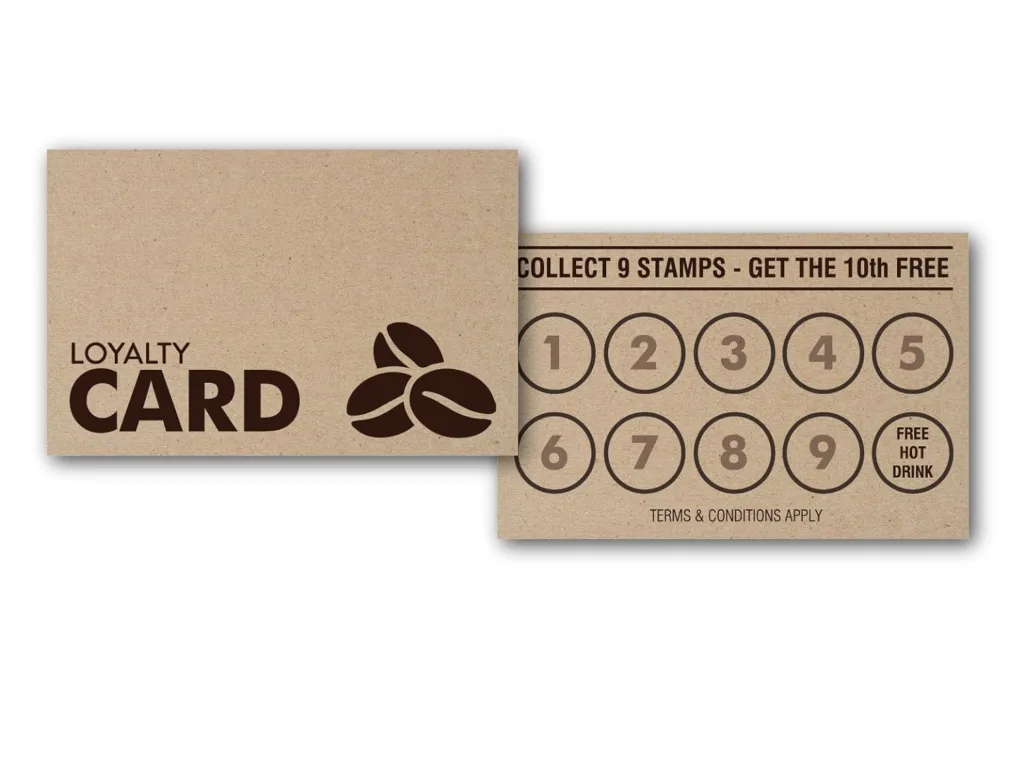Improving customer loyalty is super important for keeping your business going strong. Studies show that you’re way more likely to sell to a loyal customer, with a whopping 60% chance or more. On the other side, your chances of selling to a new customer are pretty low, ranging from just 5% to 20%.
Building up a loyal customer base takes time. You can’t make everyone a huge fan of your brand overnight. But there are things you can do right now to boost your sales without always having to find new customers.
One smart move is to start a customer loyalty program. You’ve probably seen those old-school punch cards, but nowadays, there are cool digital options to explore. Let’s check digital vs. paper loyalty cards – which is right for you.
Digital vs. Paper Loyalty Cards
Paper Stamp Cards: Pros &Cons

Pros
Using traditional punch cards as a customer loyalty tool comes with several advantages:
- Easy to Produce: Punch cards are straightforward to create. They can be designed and printed quickly, requiring minimal time and resources.
- Cost-Effective: Depending on the quality of print and design, punch cards can be relatively inexpensive to produce. Compared to more complex loyalty programs, the upfront investment is typically lower, making them accessible to businesses with tighter budgets.
- Customizable: Punch cards offer a high degree of customization. Businesses can tailor the design, layout, and rewards structure to align with their brand identity and customer preferences. This flexibility allows for creative branding and the incorporation of unique incentives.
- User-Friendly: The concept of punch cards is universally understood by customers. There’s no learning curve involved; customers grasp the concept intuitively. They simply collect punches or stamps for each purchase, making it easy for them to participate without any additional explanation.
- Appeals to Non-Tech-Savvy Customers: Not all customers are comfortable with digital technologies or mobile apps. Punch cards cater to this demographic, offering a tangible and familiar loyalty solution. This inclusivity ensures that all customers, regardless of their tech proficiency, can participate in the loyalty program.
Cons
While traditional punch cards have their advantages, they also come with several limitations:
- Limited Customer Data Collection: Punch cards do not facilitate the collection of customer information. Businesses miss out on valuable data insights that could inform targeted marketing efforts and personalized customer experiences.
- Lack of Communication: Unlike digital loyalty programs, punch cards cannot actively engage or communicate with customers. There’s no mechanism for sending targeted promotions, personalized offers, or reminders about their loyalty status or rewards.
- Program Editing Challenges: Making changes to a punch card loyalty program can be cumbersome. Any modifications to the reward structure or terms require reprinting and redistributing the cards, which can be time-consuming and costly.
- Risk of Loss or Forgetting: Physical punch cards are prone to being lost, forgotten, or damaged. Customers may misplace them or forget to bring them along for transactions, resulting in missed opportunities to earn rewards.
- Limited Program Flexibility: Punch cards have limited scope for implementing advanced loyalty features such as tiered rewards, points-based systems, or gamification elements. Businesses seeking to launch more sophisticated loyalty programs may find punch cards inadequate for their needs.
- Security Concerns: Physical punch cards are susceptible to forgery. Customers or employees may attempt to counterfeit stamps or cards, leading to fraudulent redemptions and undermining the integrity of the loyalty program.
- Inventory Management: Businesses must manage inventory levels of physical punch cards, ensuring an adequate supply is available for distribution. This adds an additional operational task and cost overhead.
- Lack of Point-of-Sale (POS) Integration: Punch card systems do not integrate seamlessly with point-of-sale systems. This means that businesses may encounter difficulties in tracking and reconciling loyalty transactions, leading to discrepancies and manual workarounds.
Digital Loyalty Program

Pros
Digital loyalty programs offer numerous advantages over paper stamp cards:
- Eliminate Loss or Forgetting: With digital programs, customers don’t need to worry about losing or forgetting their loyalty cards. Since the program is typically accessible via their smartphones, it’s always with them wherever they go.
- Easy Program Editing: Digital platforms allow for quick and seamless adjustments to loyalty programs. Businesses can easily modify rewards, update terms, or introduce new promotions without the need for costly reprints or physical distribution.
- No Inventory Management: Unlike physical cards, digital programs eliminate the need for managing inventory levels. There’s no requirement to stock or reorder loyalty cards, reducing administrative burdens and costs.
- Cost-Effective Options: Digital loyalty programs can be as affordable as traditional paper cards, depending on the service provider and features chosen. Many platforms offer scalable pricing plans tailored to the needs and budgets of businesses of all sizes.
- Direct Customer Engagement: Digital platforms enable direct communication with customers through various channels such as push notifications, emails, or in-app messages. This facilitates targeted promotions, personalized offers, and real-time engagement to drive repeat business and enhance customer loyalty.
- Data Collection and Customer Insights: Digital programs enable businesses to collect valuable customer data, including purchase history, preferences, and demographics. This data can be leveraged to personalize marketing efforts, improve customer experiences, and build stronger relationships.
- Birthday & Welcome Gifts: Digital loyalty programs make it easy to automate the issuance of birthday rewards or welcome gifts to new customers. These personalized gestures enhance customer satisfaction and foster loyalty.
- Word-of-Mouth Referrals: Digital programs can incentivize and track word-of-mouth referrals, encouraging existing customers to promote the business to their friends and family. This organic growth contributes to expanding the customer base and increasing brand awareness.
Cons
Despite their numerous advantages, digital loyalty programs also have some drawbacks:
- Limited Appeal to Older Demographics: Older customers who are less familiar or comfortable with smartphones and digital technology may find digital loyalty programs less appealing or accessible. This demographic may prefer traditional methods like punch cards, resulting in potential exclusion from the loyalty program.
- Complex Customizations: Implementing advanced customizations in digital loyalty programs, such as tiered rewards or complex points systems, can be challenging. Businesses may require technical expertise or specialized software to configure these features, which could increase implementation time and costs.
- Reliance on Tech Support: Digital loyalty programs rely on technology for operation, which means businesses may encounter technical issues or glitches that require support from IT or customer service teams. Resolving issues like changing customer cards or troubleshooting app-related problems may depend on the availability and responsiveness of tech support, potentially leading to delays in resolving customer issues.
Which one is Better?
Digital stamp cards represent the future of customer loyalty programs, offering a dynamic way to engage customers beyond their in-store experience. Unlike traditional paper cards, these digital solutions enable ongoing communication with customers, enhancing brand loyalty even after they’ve physically left your store.
Additionally, digital stamp card systems have the potential to serve as effective substitutes or complement conventional advertising channels like Facebook and Google, potentially reducing advertising costs while maintaining customer engagement.
For businesses seeking assistance with implementing digital loyalty stamp card systems and navigating the transition, platforms like GAWAPP offer valuable support and expertise. With their guidance, businesses can seamlessly integrate digital solutions into their operations, maximizing the benefits of modern technology while minimizing any potential challenges.




